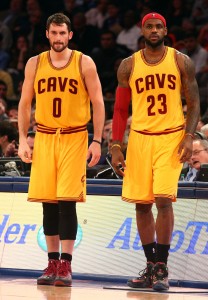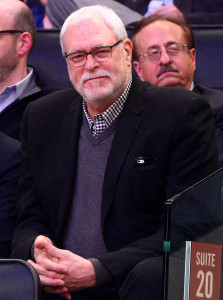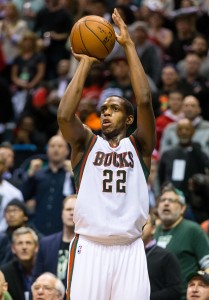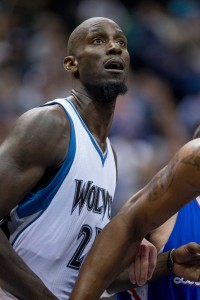Guaranteed Contracts
- Kyrie Irving ($15,800,000)1
- Anderson Varejao ($9,638,554)
- Timofey Mozgov ($4,950,000)2
- Joe Harris ($845,059)
Non-Guaranteed Contracts
- Brendan Haywood ($10,522,500)3
Options
- LeBron James ($21,573,398 — Player)4
- Kevin Love ($16,744,218 — Player)5
- J.R. Smith ($6,399,750 — Player)6
- Mike Miller ($2,854,940 — Player)7
Restricted Free Agents/Cap Holds
- Tristan Thompson ($11,916,019) — $6,777,589 qualifying offer
- Iman Shumpert ($6,542,438) — $4,433,683 qualifying offer
- Matthew Dellavedova ($1,147,276) — $1,147,276 qualifying offer8
Unrestricted Free Agents/Cap Holds
- James Jones ($947,276)
- Shawn Marion ($947,276)
- Kendrick Perkins ($947,276)
- No. 24 pick ($1,068,400)
Draft Picks
- 1st Round (24th overall)
- 2nd Round (53th overall)
Cap Outlook
- Guaranteed Salary: $26,283,613
- Non-Guaranteed Salary: $10,522,500
- Options: $52,522,306
- Cap Holds: $23,515,961
- Total: $112,844,380
The Cavaliers went through an astounding transformation in the space of one year that wasn’t limited to the obvious change that took place when LeBron James came back. To be certain, the return of James had some degree of influence on just about every move the team has made since, and even some of those that took place before, as GM David Griffin and company cleared the cap space necessary to sign him for the max. Still, only four of the players who ended the 2013/14 season on the Cavs roster are still with the team, and coach David Blatt is new, too. Griffin, in his first full year on the job, has been busy, and he’ll stay that way.
Only four Cavs have guaranteed contracts for next season, and as many as 10 players are either headed for free agency or can choose to do so. The Cavs will have to pay dearly if they’re to keep together a roster that, even with two of its three best players injured, took the Warriors to six games in the Finals. Tristan Thompson is in line for a sizable raise from his rookie scale salary of not much more than $5.138MM, and James, Kevin Love, J.R. Smith, Iman Shumpert and Matthew Dellavedova also appear likely to command raises, to varying degrees. The Cavs are reportedly bracing for a payroll that ends up between $100MM and $110MM, figures that don’t include the luxury taxes they’d incur for crossing the tax threshold, projected at only $81.6MM. Owner Dan Gilbert appears willing to pay to help Cleveland win an elusive championship, but winning isn’t just a matter of throwing money around.
That said, the Cavs will assuredly make another max offer to James when he opts out, as he’s widely expected to do in search of a two-year max deal with a player option. Cleveland will certainly accommodate that wish, moving on to the thornier issue of Love. The former All-Star whom James pushed the team to acquire didn’t appear to be the right fit for the Cavs. His numbers dropped off precipitously, and while that wasn’t thoroughly unexpected on a team with far more talent than he’d ever played with, Love nonetheless looked at times like a mere shadow of the player he was in Minnesota. That the team won two playoff series and came halfway to winning the Finals without him further speaks to the idea that the Cavs would be just fine if he weren’t there. Rumors have gone on for months suggesting Love would seek a way out, but Love has been just as persistently expressing that he’s intent on staying in Cleveland. Griffin expects the Jeff Schwartz client to opt out even though he told Chris Haynes of the Northeast Ohio Media Group in January that he planned to opt in, but it nonetheless appears as though he intends to re-sign with the Cavs. Conflicting reports paint somewhat different pictures of whether the Cavs intend to make a max offer for him. The Cavs would have a difficult time replacing him if he were to go elsewhere, so it would not be surprising if that max offer indeed goes on the table.
The return of James and Love would allow the team to keep its core intact, but so many other decisions loom about the rest of the roster. Thompson plays Love’s position, but he also shares agent Rich Paul with James, who’s indicated that he wants Thompson to stay with the Cavs. Reports show that Thompson and Paul have asked for a max or a near-max deal after rejecting a four-year, $52MM offer from the Cavs during extension talks this past fall. A max deal for Thompson would start at an estimated $15.8MM and go up by 7.5% of that initial amount each season, so it would entail far more than what Cleveland apparently offered in an extension if Thompson wants a lengthy deal. The former No. 4 overall pick could instead demand a short-term deal to more quickly reach unrestricted free agency and the escalated salary cap that’s on the horizon. A max deal, whatever its length, might not be the ideal outcome for Cleveland, given the positional overlap and Thompson’s modest career scoring average of 10.1 points per game, but retaining a talented inside force with upside, and keeping James satisfied, would have its benefits.
Smith plans to opt out and re-sign, as he told ESPN’s Chris Broussard, but the Cavs surely won’t want to lock themselves into paying a premium over a long, fully guaranteed deal to a player who’s shown as much inconsistency as Smith has over the course of his career. Eight-figure salaries seem like a reach, but Smith is surely looking for better than his nearly $6.4MM option would give him. A compromise involving salaries of $8MM or slightly more would make sense, though that’s just my speculation.
Smith’s companion in the trade that brought them both in from the Knicks is also poised to hit free agency, though Iman Shumpert’s will be of the restricted variety. That said, the advantage that Cleveland has to match all competing bids is mitigated to a degree by the knowledge other suitors have of the Cavs’ cap situation. Given Cleveland’s other plans, the Cavs wouldn’t have the means to sign a comparable replacement for Shumpert if they failed to match an offer sheet from another team. Six teams have already expressed interest in the Happy Walters client and league executives believe he’ll command salaries in excess of $8MM, Haynes reports. Still, Shumpert isn’t an elite defender; he only drew one vote in All-Defensive Team voting this year, though he was eighth among shooting guards in ESPN’s Defensive Real Plus/Minus. He’s a passable three-point shooter, but not a dangerous one, so he doesn’t quite fit the “three-and-D” mold. The 25-year-old was expected to start for the Cavs when the trade went down, but he wound up coming off the bench after Smith proved more valuable while a shoulder injury delayed Shumpert’s Cavs debut. Cleveland would have to swallow hard before matching an offer sheet with eight-figure salaries if it comes to it.
Dellavedova sure outplayed his minimum-salary deal in the Finals, but the Cavs surely won’t get carried away with a small sample size. An inflated price for Dellavedova wouldn’t cost other teams as much as it would cost the Cavs, given the team’s expected tax bill, so that would give another team incentive to come in high with an offer for him. Still, it would be surprising to see the undrafted guard end up with a salary greater than the value of the $3.376MM taxpayer’s mid-level exception next season, and if he does, Cleveland wouldn’t be wise to match an offer sheet for that sort of money.
The Cavs could use their Early Bird rights with Dellavedova to bring him back for a taxpayer’s mid-level amount and still have their actual taxpayer’s mid-level to spend on an outside free agent. The Cavs would like to add a facilitating guard who can either back up or play alongside Kyrie Irving, as Brian Windhorst of ESPN.com reported. Former Cleveland State standout Norris Cole, another Paul client and a former teammate of James on the Heat, looms as a possibility, though the Pelicans can match offers for him as a restricted free agent. So, too, is the case for the Spurs and Cory Joseph, another former first-round pick with whom the Cavs have been linked. Mo Williams reportedly has strong interest in the Cavs, but the taxpayer’s mid-level would represent a pay cut, and at 32, he’s outside the age range of 26 to 30 that Griffin has said he’ll prioritize.
Regardless of whom the Cavs might sign with that exception, Brendan Haywood‘s non-guaranteed salary gives the team a uniquely valuable trade chip. The Cavs can take in as much as $5MM more than Haywood’s salary via trade if they manage to pull off the trade after the July Moratorium but before they cross the tax threshold, or $13,253,125 if they’re already a tax team. So, technically, they could trade Haywood for David Lee, allowing the Warriors to move off Lee’s nearly $15.494MM salary and waive Hawyood’s non-guaranteed salary to help mitigate their tax bill. The efficacy for Cleveland of paying Lee that much money, plus the taxes on that amount, to compete for time at the same position as Love and Thompson play is dubious, however. The Cavs could instead dangle the Haywood contract to try to acquire just about any trade candidate on a team looking to shed salary, though it appears, from Windhorst’s latest report on the team’s efforts to find a taker for Haywood, that Cleveland is looking at modestly priced options, a sign of some level of austerity.
Still, it doesn’t seem as though the Cavs will do much holding back financially as they aim to cross the finish line after coming ever so close to a championship this year. Griffin has made it clear that he understands that as James enters his 30s, the team has no time to hesitate. The Cavs will no doubt try to win as much as they can before James’ vast abilities inevitably tail off. It’s difficult to predict exactly when that will happen, but Cleveland would be wise to plan for it. Re-signing Smith, Shumpert and others to reasonably priced short-term deals this summer will give the team a chance to get out from the tax in a few years, which could forestall repeat-0ffender tax penalties and, most crucially, allow the Cavs access to tools like the full mid-level and sign-and-trades again. Flexibility is key for NBA teams, and even as Cleveland commits to a bloated payroll for 2015/16, the Cavs can help themselves this summer if they retain as much capacity as possible to once more go through significant chances if necessary a few short years from now.
Cap Footnotes
1 — Irving’s salary will be equivalent to the league’s maximum for a player with four years of experience. That figure won’t be known until after the July Moratorium, so an estimate is used above.
2 — Mozgov’s salary was originally in the form of a team option, but the Nuggets have picked up that option.
3 — Haywood’s salary would become fully guaranteed if he remains under contract through August 1st.
4 — The cap hold for James if he opts out would be the lesser of $24,773,280 and the league’s maximum salary for a player with 10 or more years of experience. It’d almost certainly be the latter, an estimated $22,120,000.
5 — The cap hold for Love if he opts out would be the lesser of $23,578,593 and the league’s maximum salary for a player with seven to nine years of experience. It’d almost certainly be the latter, an estimated $18,960,000.
6 — The cap hold for Smith would be $9,773,265 if he opts out.
7 — The cap hold for Miller would be $3,278,400 if he opts out.
8 — The cap hold for Dellavedova would be $947,276 if the Cavaliers elect not to tender a qualifying offer.
The Basketball Insiders Salary Pages were used in the creation of this post.




